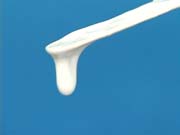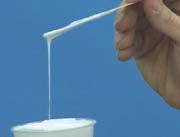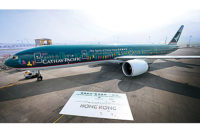
As adhesive users continue to work toward reducing adhesive costs and improving production efficiencies, foaming water-based adhesive is quickly becoming a star player.
Foaming is not a new concept; plywood has been manufactured using this technology for many years. The first attempt to bring foaming to the converting market occurred in the 1980s. This failed due to resistance from adhesive and converting equipment manufacturers. Today's end users are more informed about the benefits associated with foaming. In addition to substantial adhesive cost savings, adhesive end users understand that products manufactured with foamed adhesive have less warp, resulting in another cost savings: less waste. This has presented adhesive manufacturers with puzzling challenges, but has left the adhesive end user with the double benefit of cost savings plus better product.

The foamed adhesive is supplied to the application point and used in exactly the same manner as a non-foamed adhesive.
The two main types of adhesive foaming systems are high-shear and low-shear. The critical difference is in the design of the mixing head. High-shear mixers are designed with concentric rows of mixing teeth covering a front stator, rear stator and rotor. These mixing heads have slim mixing-head profiles and low residence time. Low-shear mixers have "pins" instead of teeth inside an elongated mixing chamber. To compensate for the lower shear "pins," the mixing head is elongated for longer residence time. This raises the temperature of the foamed adhesive as it passes through the head, resulting in poor product stability and significantly lower cost savings for the end user. For the application of foaming adhesive, it is best to use a high-shear mixing head and a system that will consistently produce uniform micro-cellular foam.
It is important to size the foaming equipment to an application and to ensure that the foamer can adjust to meet customer needs and applications. One size does not fit all when it comes to foaming a water-based adhesive.
BENEFITS OF FOAMING
Foaming brings the following benefits to the end user.- Better lay flat: less glue means less water
- Better bond: more adhesive at the interface of the substrates
- Better hold out on absorbent substrates
- Improved open times
- Faster setting
- Increased wet tack
- Improved filming characteristics
- Reduced adhesive usage, up to 50%
APPLICATIONS FOR FOAMING
Foaming was reintroduced to the converting market several years ago, first in single-face laminating and later into both the converting and product assembly markets. The single-face application lent itself very well to foaming due to the need for reduced warp, cost reduction pressures and the large volume of adhesive used.Following are the only limiting factors to foaming.
- The ability of the adhesive companies to formulate a foam-friendly version of their adhesive brand
- A low coat weight limit, usually 1 mil.
- An application method not suitable for foaming, e.g., recirculating adhesive system, spray, etc.
CONVERTING:
Single-face laminatingBulk-box laminating
Tube winding
Paper-to-paper laminating
Artist mat board
Ceiling tiles
Foam-to-paper and -board
Multi-wall bags
PRODUCT ASSEMBLY:
HPL laminatingDoor manufacturing
Paper and vinyl to particle board, MDF, Lauan and gypsum
Drawer wrap
FSK to OSB
Panel manufacturing
Veneering
FORMULATION CONSIDERATIONS
Foaming is compatible with most water-based adhesives, including: PVA, VAE, Dextrin, starch based, acrylics, UF resins, casein, and polyvinyl alcohol. As stated earlier, it is paramount to good foaming that the defoamer be removed from the adhesive manufacturing process. A typical adhesive with defoamer will only accept about 15% air and the foam will be very unstable, resulting in very little, if any, actual benefits.When formulating a foam-able adhesive for an application, these basic fundamentals need to be kept in mind.
- Let the foamer do the foaming. In order to achieve the desired density reduction and to keep the adhesive stable, the foam needs to be produced by the foamer only. If the adhesive continues to foam upon introduction to the application point, the adhesive will become "overfoamed" and will not perform. The addition of foaming agents to a formulation is usually not needed.
- The application method will determine formulation. Considerations must include the type of roller being used, the amount of shear the foamed adhesive will be subjected to on the roller, and whether or not it is an extrusion application.
- The adhesive must perform both foamed and un-foamed. An adhesive must not be formulated in such a way so it will only work for a customer when it is foamed.
- If a customer could use a filled product, they would be using it now. Foaming will not change the basic bonding characteristics of an adhesive. Trying to recover lost margin dollars by filling a product with clay or calcium carbonate will only result in adhesive failures.
- In almost all cases, the only defoamer that can be in the adhesive is the defoamer that is in the raw polymer itself. Even a very small amount of defoamer added to an adhesive to aid in the adhesive manufacturing process will dramatically decrease the foamability of the adhesive and its effectiveness for an application.
- Highly plasticized PVAs (10%+) will not foam as well. The addition of a surfactant may be needed.
- Foaming increases viscosity. Foamable adhesives are usually lower in viscosity. Determine the lowest possible viscosity for an application and then formulate the adhesive.
- Foaming changes the rheology of an adhesive. The flow characteristic of an adhesive will change as the amount of air increases. This change allows a foamed adhesive to act as a void filler and to stay where it is applied, keeping more of the adhesive at the substrate interface.
- Upper limit to density reduction. When an adhesive is foamed, the density is reduced by the amount of air that is incorporated into the adhesive, usually in the 10-45% range. It is usually not recommended to reduce the density by more than 50%. At this point, the foamed adhesive begins to act like a solid rather than a liquid, and problems can occur with the application.

MARKETING STATEGIES
With the continual expansion of foaming into a wider range of markets and applications, adhesive manufacturers are presented with a new set of challenges. In a market that is static, at best, for water-based adhesives, manufacturers are struggling to maintain market share and margins, let alone trying to increase sales. To adhesive sales managers, adhesive foaming is a new opportunity as well as a nightmare. Ignoring this technology will lead to lost sales dollars and reduced market share. Addressing foaming only when forced to by a customer who expresses an interest in foaming will send the wrong message to that customer. Adhesive manufacturers that proactively develop foamable adhesives as well as a viable market strategy will benefit from the expansion of foaming into the marketplace.
One possible strategy would be to develop primarily foamable adhesives regardless of whether the customer plans to foam or not. Remember, the adhesive needs to work both foamed and unfoamed. By using this strategy, a manufacturer can avoid a dual product line and keep costs down. The advantage to a single product line would be that if a customer is using a foamable product but not foaming and then wishes to foam their adhesive, they can use the same product, eliminating down time with prolonged testing procedures and any necessary approvals or certifications.
Producing foamable adhesive may result in adhesive manufacturing issues that need to be addressed. Static in-line mixers can be used in the manufacturing process to eliminate air incorporation and to allow cup weight specifications to be met. Large adhesive companies that polymerize both PVA and VAE can formulate products right out of the reactor and thereby eliminate some of the issues presented to a formulator of adhesives.
CONCLUSION
Foaming is here to stay. The benefits that can be gained by foaming water-based adhesives are significant and will continue to drive the expansion of this technology into more markets and applications. The adhesive manufacturer that recognizes this and can develop a market strategy designed to protect current sales (as well as address new opportunities) will be the company to prosper.For more information on foaming, contact Don Berlin, E.T. Oakes Corp., 686 Old Willets Path, Hauppauge, NY 11788; phone (631) 232-0002; fax (631) 232-0170; or visit http://www.oakes.com .
